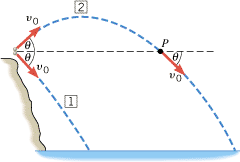From the top of a cliff overlooking a lake, a person throws two stones. The stones have identical initial speeds v0, but stone 1 is thrown downward at an angle q below the horizontal, while stone 2 is thrown upward at the same angle above the horizontal, as Figure 3.15 shows. Neglect air resistance and decide which stone, if either, strikes the water with the greater velocity.
 |
|
Reasoning and Solution We might guess that stone 1, being hurled downward, would strike the water with the greater velocity. To show that this is not true, let’s follow the path of stone 2 as it rises to its maximum height and falls back to earth. Notice point P in the drawing, where stone 2 returns to its initial height; here the speed of stone 2 is v0, but its velocity is directed at an angle q below the horizontal. This is exactly the type of projectile symmetry illustrated in Figure 3.14. At this point, then, stone 2 has a velocity that is identical to the velocity with which stone 1 is thrown downward from the top of the cliff. From this point on, the velocity of stone 2 changes in exactly the same way as that for stone 1, so both stones strike the water with the same velocity.
Related Homework: Problems 37, 65